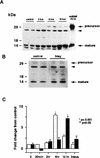Activity-dependent activation of TrkB neurotrophin receptors in the adult CNS
- PMID: 10492004
- PMCID: PMC311290
Activity-dependent activation of TrkB neurotrophin receptors in the adult CNS
Abstract
In this paper we have investigated the hypothesis that neural activity causes rapid activation of TrkB neurotrophin receptors in the adult mammalian CNS. These studies demonstrate that kainic acid-induced seizures led to a rapid and transient activation of TrkB receptors in the cortex. Subcellular fractionation demonstrated that these activated Trk receptors were preferentially enriched in the synaptosomal membrane fraction that also contained postsynaptic glutamate receptors. The fast activation of synaptic TrkB receptors could be duplicated in isolated cortical synaptosomes with KCl, presumably as a consequence of depolarization-induced BDNF release. Importantly, TrkB activation was also observed following pharmacological activation of brain-stem noradrenergic neurons, which synthesize and anterogradely transport BDNF; treatment with yohimbine led to activation of cortical TrkB receptors within 30 min. Pharmacological blockade of the postsynaptic alpha1-adrenergic receptors with prazosin only partially inhibited this effect, suggesting that the TrkB activation was partially due to a direct effect on postsynaptic cortical neurons. Together, these data support the hypothesis that activity causes release of BDNF from presynaptic terminals, resulting in a rapid activation of postsynaptic TrkB receptors. This activity-dependent TrkB activation could play a major role in morphological growth and remodelling in both the developing and mature nervous systems.
Figures















Similar articles
-
BDNF acutely increases tyrosine phosphorylation of the NMDA receptor subunit 2B in cortical and hippocampal postsynaptic densities.Brain Res Mol Brain Res. 1998 Mar 30;55(1):20-7. doi: 10.1016/s0169-328x(97)00349-5. Brain Res Mol Brain Res. 1998. PMID: 9645956
-
Truncated trkB receptors on nonneuronal cells inhibit BDNF-induced neurite outgrowth in vitro.Exp Neurol. 1997 Dec;148(2):616-27. doi: 10.1006/exnr.1997.6699. Exp Neurol. 1997. PMID: 9417837
-
Pre-synaptic kainate receptor-mediated facilitation of glutamate release involves PKA and Ca(2+) -calmodulin at thalamocortical synapses.J Neurochem. 2013 Sep;126(5):565-78. doi: 10.1111/jnc.12310. Epub 2013 Jun 11. J Neurochem. 2013. PMID: 23692284
-
Role of the brain-derived neurotrophic factor at glutamatergic synapses.Br J Pharmacol. 2008 Mar;153 Suppl 1(Suppl 1):S310-24. doi: 10.1038/sj.bjp.0707509. Epub 2007 Dec 3. Br J Pharmacol. 2008. PMID: 18059328 Free PMC article. Review.
-
Induction of non-catalytic TrkB neurotrophin receptors during lesion-induced synaptic rearrangement in the adult rat hippocampus.Prog Brain Res. 1995;105:197-210. doi: 10.1016/s0079-6123(08)63296-3. Prog Brain Res. 1995. PMID: 7568878 Review. No abstract available.
Cited by
-
Role for Endogenous BDNF in Endocannabinoid-Mediated Long-Term Depression at Neocortical Inhibitory Synapses.eNeuro. 2015 Feb 28;2(2):ENEURO.0029-14.2015. doi: 10.1523/ENEURO.0029-14.2015. eNeuro. 2015. PMID: 25938134 Free PMC article.
-
Repeated social defeat and the rewarding effects of cocaine in adult and adolescent mice: dopamine transcription factors, proBDNF signaling pathways, and the TrkB receptor in the mesolimbic system.Psychopharmacology (Berl). 2017 Jul;234(13):2063-2075. doi: 10.1007/s00213-017-4612-y. Epub 2017 May 2. Psychopharmacology (Berl). 2017. PMID: 28466092
-
Neurotrophin ligand-receptor systems in somatosensory cortex of adult rat are affected by repeated episodes of ethanol.Exp Neurol. 2007 Apr;204(2):680-92. doi: 10.1016/j.expneurol.2006.12.022. Epub 2007 Jan 8. Exp Neurol. 2007. PMID: 17320080 Free PMC article.
-
TrkB agonists prevent postischemic emergence of refractory neonatal seizures in mice.JCI Insight. 2020 Jun 18;5(12):e136007. doi: 10.1172/jci.insight.136007. JCI Insight. 2020. PMID: 32427585 Free PMC article.
-
Evidence that brain-derived neurotrophic factor from presynaptic nerve terminals regulates the phenotype of calbindin-containing neurons in the lateral septum.J Neurosci. 2000 Jan 1;20(1):274-82. doi: 10.1523/JNEUROSCI.20-01-00274.2000. J Neurosci. 2000. PMID: 10627605 Free PMC article.
References
-
- Androutsellis-Theotokis A, McCormack WJ, Bradford HF, Stern GM, Pliego-Rivero FB. The depolarisation-induced release of [125I]BDNF from brain tissue. Brain Res. 1996;743:40–48. - PubMed
-
- Altar CA, Cai N, Bliven T, Juhasz M, Conner JM, Acheson AL, Lindsay RM, Wiegand SJ. Anterograde transport of brain-derived neurotrophic factor and its role in the brain. Nature. 1997;389:856–860. - PubMed
Publication types
MeSH terms
Substances
LinkOut - more resources
Full Text Sources
